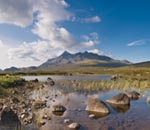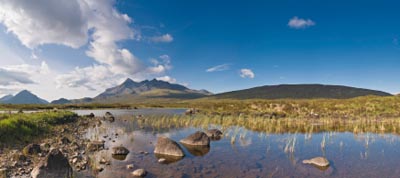The magic of the Outer Hebrides
David Profumo rejoices in the wild landscapes of the Outer Hebrides


Some say they got their name from a misprint in Pliny, others that it derives from the Viking for ‘islands on the edge of the sea'. They have even been called God's Necklace. Whatever you call them, the chain of 500-odd islands that make up the Outer Hebrides on the western fringes of this kingdom are geologically the oldest shoulder of Europe.
You can fly there, but I suggest you arrive by sea. On my first visit (in 1975), I stood at dusk on the bows of the ferry as it approached the haphazard harbour of Tarbert, and watched in awe as the sentinel hills of Harris reared ahead. Even in the faltering light, as we turned down the switchback road to the south, I could see I was hurtling through an otherworldly landscape: grey heaves of ancient gneiss bulging up through threadbare moorland, leaking peat hags, curry-combed lines of ‘lazy-beds' where the crofters had raked up seaware to grow crops, lochans gleaming like scales, low stone dwellings with their doorways turned away from the prevailing winds. This was a far cry from the tartan and shortbread image of the Highlands as the islanders like to say: ‘On a clear day, across the Minch, you can see Scotland.'
This archipelago from the Butt of Lewis down to Barra was once a single landmass, and is still referred to as the Long Island. Harris is typical in showing two faces. On its eastern shoreline (where my in-laws have their croft), there is a series of shattered headlands, skerries and bays where life has always been hard, and the topsoil is so thin they couldn't even bury the dead. So the inhabitants of this Bays area-from Cluer, Geocrab and Flodabay-carried their coffins across to the more fertile western shore; you can still see the cairns by the old track where they would rest the bier.

For the visitor, this severe coast offers a ramshackle beauty. The glancing marine light, the squalling seabirds and the pervasive air of dereliction make perhaps for an acquired taste-this is remote Britain, as far from Westminster as Italy is. Even in the 1970s, a census recorded several hundred monoglot Gaels here-taxpayers who couldn't speak any English. Small wonder that incomers are still regarded as ‘white settlers'.
Crossing to the western seaboard, where the Atlantic uses the stormshore as an anvil, you discover a lovely succession of white beaches. Just inland of the marram dunes lies a counterpane of machair-pasture enriched by winnowed shells-where sea pinks, harebells and frog orchids abound in season. Traigh Luskentyre is perhaps the most spectacular strand; park by the ceme-tery (where lies a Nisabost man so profane in life that nothing will grow on his grave) and clamber up for a prospect of the widely furling ocean, chalked in the distance with whitecaps. Your senses will be infused with ozone.
On your return, call in at the workshop of Donald John Mackay, one of the few remaining old-school weavers of tweed. Gone are the days when homespun was a widespread cottage industry, and local wool was dyed with lichen or heather and fixed in human urine, but this oily, hirsute cloth is still a household name, and, if you run a web of it through your hands, test the texture and sniff its tang, you savour something essential of the roughness and purity of the Long Island.
Ideal beach days are relatively rare. It's fre-quently wet, although you'll see few umbrellas. Life here is in thrall to the weather, and the moods of the sea. ‘The thing about the North Wind,' explains our friend Flora Anne, ‘is that it blows from all directions.' Sometimes, it's best to be snug inside, with books, board games and a peat-smoke fug, as the rain pelts at your windowpanes like swan shot.
Sign up for the Country Life Newsletter
Exquisite houses, the beauty of Nature, and how to get the most from your life, straight to your inbox.
On soft days, we potter about in boats, although I have been a landlubber of some conviction since a killer whale in search of his lunchtime seal pup breached rather too close to the rubber dinghy I was rowing. More intrepid sailors favour these waters. One evening, in a tiny harbour, I was trying hamfistedly to secure a mooring when an amused snort of laughter drifted from the deck of a modest yacht nearby, and there was The Princess Royal, enjoying her sundowner.
Everywhere in the Long Island are ruined signs of previous habitation. Emigration, clearances, unemployment and maritime losses in the two World Wars have all taken their toll, and the Outer Hebrides have a total population only marginally greater than that of the Prime Minister's constituency town of Witney. Nowhere is this deep historical absence more arrestingly clear than on St Kilda, the famously remote island group some 50 miles off Harris, evacuated in 1930. T
ry walking along the deserted crescent of The Street-site of the daily ‘Parliament' and stand in the small green graveyard there: it's as numinous a place as I know. Nearby rears the highest precipice in the UK, where generations of splay-footed cragsmen snared gannets and puffins (boiled fulmar in porridge was the usual village breakfast). Frequently, they fell into the sea-like most Hebrideans, they couldn't swim.
If you drive up from Harris to its larger Siamese twin-Lewis-you pass through the dinosaur hills and descend to a less craggy, acidic moorland ‘the colour of grizzly bears and burnt toast', according to the poet Louis MacNeice. You can head for Storno-way, administrative capital of the Outer Hebrides and once a hub of the herring industry, but, these days, it seems hung over and disaffected. I only go there for ‘messages' (as shopping is called).
One emporium, which claims to sell everything from an anchor to a needle, is run by third-generation Asians, referred to with neutral accuracy as the ‘darkies'. Quite a few Lewis inhabitants have darkish looks, said to be Hispanic blood from shipwrecked survivors of the Armada, but then there's a Nordic strain, too, from the days of the Vikings. Archaeology is only just unravelling the skeins of cultural influence in these islands.
It's traditional for visiting writers to mention two other influences: whisky and Calvinism. Despite the image of Wee Free dourness, Hebridean religion is, in practice, remarkably diverse, with Protestantism giving way to the Catholics when you reach Benbecula. Sabbatarianism may be loosening its grip, but the islands still feel less secular than the mainland.
And, whatever your beliefs, it's surely quite hard not to experience some kind of spiritual impulse when Mother Nature is whirling around you in such an elemental fashion. Prove me wrong by visiting the spectacular megaliths at Callanish, like a circle of stone mourners huddling toward the sea, or the Rodel tomb of that old Jaco-bite warrior Donald Macleod, who married again at 75, ‘leapt like a salmon' into the bed of his new bride, and fathered nine more children. Traveller, doff your bonnet.
Migration, travelling-these seem to be the Long Island motifs. Under the first full Moon in November come snipe, skimming so low over the waves their breast feathers are frosted with brine. Later, it's the woodcock, which overfly the Uists, still searching for Tir-na-Nog, the Atlantis of Gaeldom. Prince Charlies, Bonny and current, have sought haven here. Turtles and coconuts turn up on the Gulf Stream. From the croft, we've seen basking sharks, conning towers of submarines and the Northern Lights. There's something beguiling about these furthest margins of our land, where the sun casts its silver net over the dark reaches of the sea.
* Subscribe to Country Life and up to £50
Country Life is unlike any other magazine: the only glossy weekly on the newsstand and the only magazine that has been guest-edited by HRH The King not once, but twice. It is a celebration of modern rural life and all its diverse joys and pleasures — that was first published in Queen Victoria's Diamond Jubilee year. Our eclectic mixture of witty and informative content — from the most up-to-date property news and commentary and a coveted glimpse inside some of the UK's best houses and gardens, to gardening, the arts and interior design, written by experts in their field — still cannot be found in print or online, anywhere else.
-
 ‘It had the air of an ex-rental, and that’s putting it politely’: How an antique dealer transformed a run-down Georgian house in Chatham Dockyards
‘It had the air of an ex-rental, and that’s putting it politely’: How an antique dealer transformed a run-down Georgian house in Chatham DockyardsAn antique dealer with an eye for colour has rescued an 18th-century house from years of neglect with the help of the team at Mylands.
By Arabella Youens
-
 A home cinema, tasteful interiors and 65 acres of private parkland hidden in an unassuming lodge in Kent
A home cinema, tasteful interiors and 65 acres of private parkland hidden in an unassuming lodge in KentNorth Lodge near Tonbridge may seem relatively simple, but there is a lot more than what meets the eye.
By James Fisher